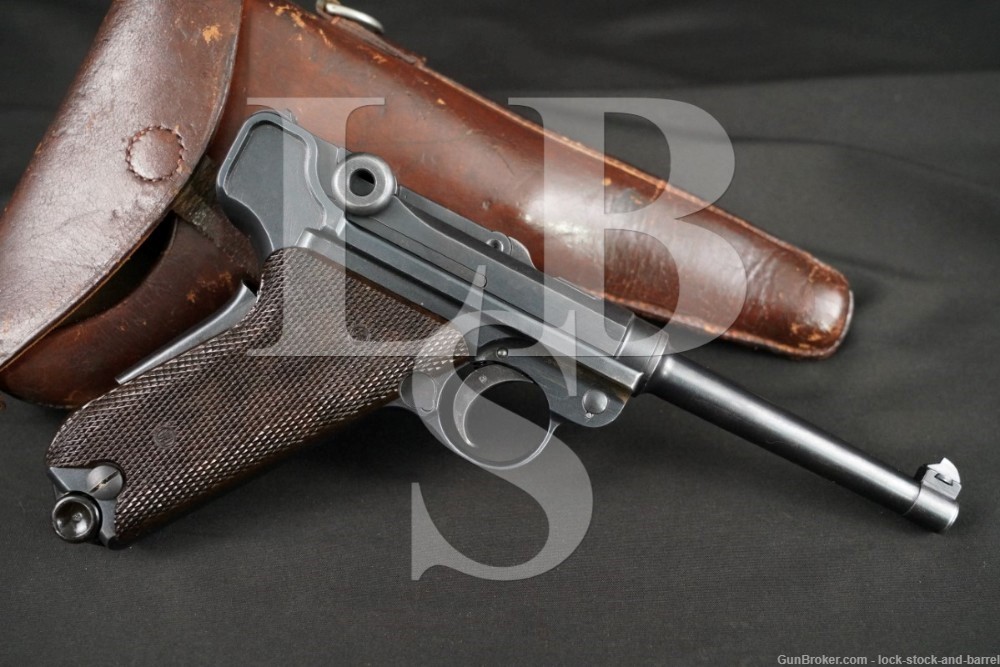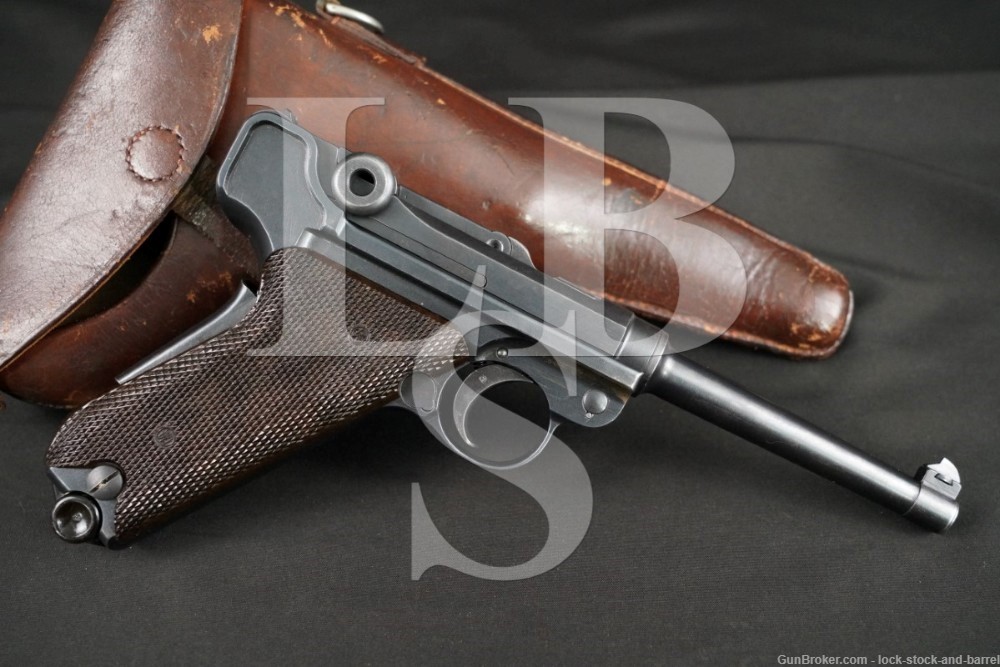
Swiss F+W Bern Luger M06/29 7.65mm 4.75″ Toggle Action Semi-Auto Pistol C&R
SOLD FOR: $1925
LSB#: 220519BM020
Make: Waffenfabrik Bern (F+W)
Model: Ordnance Pistol Model 06/29, Luger
Serial#: 71903
Year of Manufacture: 1944, C&R
Caliber: 7.65mm Luger
Action Type: Toggle-Action Semi-Automatic Striker-Fired Pistol fed by a Detachable Magazine with a Grip Safety
Markings: The barrel is marked “71903”, which is the serial number, and has a cross inside a shield at the top near the chamber ring and is marked with a cross at the bottom.The lug at the bottom of the chamber ring is marked “903”. The bottom right portion of the slide is marked “CN” next to a cross and “3” . The bottom left portion of the slide is marked with a rifle marked “N” in the middle (“N” stands for Neuhausen and is a marking which was used by SIG), the mark indicates the composition of the steel. The extractor, situated at the top of the breechblock, is marked “GELADEN” which is German for “loaded”. The firing pin is marked with a cross. The front toggle is marked with the Swiss nation crest at the top and “CN” adjacent to a cross next to “S” inside an oval at the bottom. The rear toggle is marked with the serial number “71903” at the top and “Mo” adjacent to a cross at the bottom. The coupling link is marked “CN” adjacent to a cross. The concealed portion of the frame is marked “44” under the locking bolt at the front, which is the date code, and has a rifle marked “N” proof at the rear end. The rear of the trigger side-plate is marked “903”. The left side of the frame is marked with the “F+W” logo and “71903”. The rear of the frame is marked with the “F+W” logo. The front of the trigger guard is marked “P”. The right side of the trigger is marked “F+W”. The left side of the frame is marked “S”. to indicate the safe position. The grip panels are marked “F+W” inside an oval and “MA / 1493”.
Barrel Length: 4.75”
Sights/ Optics: The front sight is blade dovetailed to a banded base fixed by the muzzle. The rear sight is a “U”-notch integral to the rear toggle link.
Stock Configuration & Condition/ Grip: The grip panels are two-piece checkered synthetic, the left panel is black and the right panel is brown. The grip panels have some light handling marks, nicks and scuffs. The checkering remains sharp. There are no chips or cracks. Overall, the grip panels are in Very Good condition.
Type of Finish: Blue
Finish Originality: Original
Bore Condition: The bore is mostly bright with sharp rifling. There is light erosion concentrated in the grooves.
Overall Condition: The pistol retains about 90% of its metal finish. The gun has some light handling marks, nicks and scuffs. Notably, there is light finish loss along the leading edges, light wear around the muzzle and some light surface oxidation visible in the recesses. The markings remain clear. The screwheads are only lightly tooled and remain serviceable. Overall, the pistol is in Very Good plus condition.
Mechanics: The action functions correctly. There is barely palpable play between the barrel assembly and frame. We did not fire this pistol. As with all used firearms, a thorough cleaning may be necessary to meet your maintenance requirements.
Box Paperwork and Accessories: The pistol comes with a single magazine and Swiss military holster for a Model 1900 Luger. The magazine has some light handling marks but it remains in Very Good condition. The brown leather holster has a stamped between the belt loops, the stamp is marked “L.G. WALTHER / 06 / SATTLER BERN”. Under the flap there is a marking that has been penciled in (please see photos). The holster has scattered light-moderate handling marks but it remains in Very Good condition.
Our Assessment: The Parabellum-Pistole, commonly referred to as the Luger, was designed by Georg Johann Luger. Luger was an unlikely gun designer, born in 1849 he was the son of a surgeon, Bartholomaeus von Luger, and while attending university he served as a One-Year Volunteer with the 78th Infantry Regiment (Infanterieregiment 78 ein) of the Austro-Hungarian Army. While in the military Luger proved himself a skilled marksman and he began to develop an interest in the small arms technology. Following four years of service Luger worked a number of jobs in Vienna. Finally, in the 1870s Luger met Ferdinand Ritter von Mannlicher who recruited him as a sales representative for Deutsche Waffen und Munitionsfabrik AG (DWM). One of the company’s weapons that Luger marketed was the Borchardt C93 (named after its designer Hugo Borchardt) which was criticized for being too heavy and poorly balanced. Luger decided to rework the design and eventually secured a contract for his new pistol with the Swiss Army which dubbed it the model 1900 which was chambered for 7.65mm Parabellum cartridges. After some minor reworking Luger introduced the Pistole 1904, chambered for 9mm cartridges, which was adopted by the Imperial German Navy, the pistol was henceforth referred to as the Luger. A slightly altered version of the pistol with a smaller barrel was adopted for service by the Prussian Army in 1908, hence the designation P08. The P08 would become one of the most iconic weapons of the 20th century. Following the end of WWI Luger was bankrupted, he had invested in War Bonds which had become worthless following Imperial Germany’s defeat and worse yet he was forced out of his job by his employer DWM which sought to appropriate his patents. The ensuing legal dispute between Luger and DWM would be decided in his favor in 1922, but he was financially ruined by that time and passed away the following year at the age of 74. His pistol would continue to serve the German military during WWII (although the P38 was the Wehrmacht’s standard issue sidearm) and saw service in a number military and police forces after the war.
Although the most famous variant of Georg Luger’s iconic design was the P.08, the pistol was also adopted by Switzerland for military use. The Swiss adopted the Model 1900 chambered for 7.65mm cartridges in 1901 and a slightly improved variant was adopted several years later, the Model 1906. These early pistols were manufactured by DWM and imported by the Swiss until 1918 when WWI turned decidedly against Germany, henceforth Waffenfabrik Bern began to domestically fabricate the M1906. In 1929, Switzerland introduced a domestic variant of the Parabellum Pistole, the Model 1906/29 which superseded the M1906, it featured a number of small improvements. Standard issue Swiss Lugers were chambered for the 7.65mm cartridge until the Swiss Luger was ultimately superseded by the SIG P210, the 9mm cartridge was never formally adopted for use with the 906/29 although experimental variants were created. The Swiss Army managed to avoid being drawn into both World Wars and their Lugers are generally better preserved then the German guns which saw extensive service in both World Wars and numerous smaller conflicts. This gun has some light handling marks, but it is nicely preserved. The markings are clear with the parts all serial matched. The holster is for an older variant of the Swiss Luger, but it fits this gun nicely. This is a beautiful handgun that is both ergonomic and mechanically sound. For fans of the Luger and military history, this is the gun for you. Good luck on your bid!

